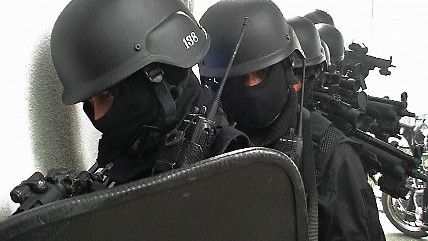Pre-Dawn No-Knock SWAT Raid for Minor Drug Charge Ruled Unconstitutional
2015 militarized raid resulted in "fifth-degree drug possession." That's the lowest drug charge possible.

A Hennepin County (Minn.) drug squad — known as the Emergency Services Unit (ESU) — conducted a pre-dawn no-knock raid on a house in North Minneapolis one morning in November 2015. They were looking for Walter Power, who they suspected of being a marijuana dealer. To search the home they believed Power to be sleeping in, they brought a force of between 28-32 officers, most clad in riot gear and carrying rifles, accompanied by a sniper seated atop a Ballistic Engineered Armored Response (BEAR) vehicle.
Why did law enforcement officials feel they needed to display a show of overwhelming force that would be intense even in a foreign occupied city? Because the primary resident of the house, Michael Delgado, was a registered gun-owner with a license to carry.
Convinced of the potential danger posed to officers when raiding a house with an armed occupant, Hennepin County District Judge Tanya Bransford signed off on the no-knock raid, but later told the Minneapolis Star-Tribune that she did not know a platoon of up to 32 officers would be deployed to search the house, or that they'd throw flash bang grenades through the windows in addition to knocking down doors.
The raid resulted in the arrest of Power — the suspected marijuana dealer — for "fifth-degree drug possession," the lowest possible drug charges on the books. Even this modest charge would be dropped after Judge Bransford declared the raid unconstitutional in a ruling last summer, arguing that Delgado and Power had been subject to unreasonable search and seizure in violation of the Fourth Amendment. Bransford wrote in her ruling "that the types of militarized actions used in this case seem to be a matter of customary business practice," which she found troubling.
Like most of the U.S., Hennepin County has increasingly relied on SWAT teams to serve warrants. According to the Star-Tribune, its ESU deployed 71 times last year, which is more than double its annual usage from a decade prior. A 2014 study by the American Civil Liberties Union (ACLU) found that on a national basis, SWAT teams were only used "for hostage, barricade, or active shooter scenarios" in seven percent of all deployments, while 62 percent of SWAT raids were to search for drugs.
The executive director of the Minnesota Sheriff's Association, Jim Franklin, was quoted by the Star-Tribune as saying of Bransford's ruling, "My question to her is: Are you going to attend the dead cop's funeral?" Franklin's argument is essentially that without the use of such violent and destructive tactics, officers' lives would be at risk. But no-knock raids can and do result in the deaths of officers, because few things will make even reasonable people turn violent like a sudden and shocking attack on their home.
In 2006, former Reasoner Radley Balko wrote about the case of Cory Maye, a Mississippi man who ended up on death row after shooting an officer entering his home during a no-knock raid. Maye would be released from prison on 2011, following a plea agreement to charges of manslaughter.
Watch the Reason TV doc on Maye's case below.


Show Comments (185)